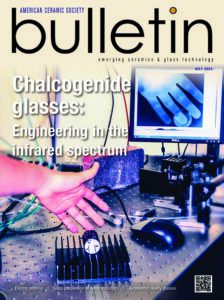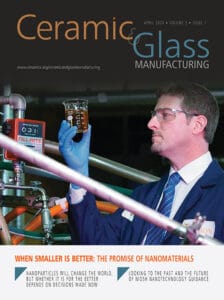It is rar e in our modern technical world to have only a single employer throughout one’s full career, but that has been my experience from graduation through retirement and for 16 years beyond retirement. As an undergraduate, I studied material science with a specialty in metallurgy at the Pennsylvania State University and received my BS degree in 1969. In looking at opportunities for graduate studies, I was enticed to stay at Penn State and work on creep and mechanical properties of ceramics. I accepted their offer and received my PhD from Penn State in 1974.
e in our modern technical world to have only a single employer throughout one’s full career, but that has been my experience from graduation through retirement and for 16 years beyond retirement. As an undergraduate, I studied material science with a specialty in metallurgy at the Pennsylvania State University and received my BS degree in 1969. In looking at opportunities for graduate studies, I was enticed to stay at Penn State and work on creep and mechanical properties of ceramics. I accepted their offer and received my PhD from Penn State in 1974.
While interviewing for a job, one industrial research laboratory stood out. General Electric, which in the 70’s was a huge conglomerate of diverse businesses, had its central research lab in Niskayuna, NY. At the time, the lab was known as the GE Corporate Research and Development Center. The various businesses within GE designed and built all sorts of devices and systems with critical dependencies on ceramics. Those businesses included lighting systems, nuclear fuels, electrical switching devices, electronic devices, defense systems, space satellite systems, gas turbines for electrical generation, and gas turbines for aviation propulsion. This job looked like a literal smorgasbord of opportunities to exercise my newfound understanding of ceramics. Luckily, GE offered me a position at what is now known as the GE Research Laboratory. I accepted and started working there just after my thesis defense in late 1973.
On my first day at GE, I was asked to join a team developing a new version of SiC that could be sintered to high density from powders without hot pressing. Our vision—in a sense, our charter—was to make this fabricable, high temperature version of SiC suitable for use as a structural material in GE’s gas turbines. Many properties seemed as good or better than the metallic superalloys being used. The glaring shortcoming was the low fracture toughness of monolithic SiC. Sintered SiC did not revolutionize GE’s turbines, but the effort served as a wonderful experience to “get my feet wet” at GE. And that effort started a career-long quest to use ceramics in the hot sections of gas turbines to increase turbine performance.
Over the years, I worked with each of the GE businesses listed earlier. My role was generally related to fabrication processes, strength improvement, fracture analysis, reliability and durability. But over the years, my work always seemed to return to the two gas turbine businesses. In the 1990s, I led a team that successfully introduced and optimized versions of ceramic thermal barrier coatings on hot-section components for both businesses. But the long-term carrot was still ceramic structural components. To meet the challenge of low fracture toughness in monolithic ceramics, we needed to develop tough ceramic matrix composites. That was accomplished in a family of CMCs utilizing SiC fibers in a matrix of SiC. While I participated in the CMC development related to the fiber strength and toughening mechanisms, most of my contribution has been in development of external coatings for the CMCs that protect the SiC from oxidation and other degradation when exposed to the hot combustion gas. These coatings, known as environmental barrier coatings, are critical to ensuring adequate component life and durability.
I retired from GE Research as a principal scientist in 2008 as these CMCs systems were being demonstrated and optimized in both land-based and aero gas turbines. But I was quickly lured back to GE on a part-time basis to help finish that job. Since then, GE Aerospace has introduced CMCs into hot sections of commercial aircraft that have now accumulated millions of hours of successful flight time. It has been a gratifying personal experience to be part of this quest for so long and to see it to successful completion.
An important tangent to my GE career was related to a close technical cooperation with the Center for Thermal Spray Research at Stony Brook University. In 2009, I was appointed as an Adjunct Professor in the Department of Material Science and Engineering, which allowed me to mentor many young, enthusiastic, clever graduate students. Working with such students has always been invigorating.
Through the course of my career, I have published over 30 technical papers and have been granted 56 US patents. I have been honored by the American Ceramic Society by being elected as a Fellow in 2012 and with the James I. Mueller Award and Lecture in 2009. I have been recognized by the AVS in its R.F. Bunshah Award, and by TMS for a distinguished career. Within GE, I have been awarded three Dushman Awards for group technical achievements with significant business impact.
My association with the American Ceramic Society has spanned my full career and has enabled my successes. As a member of the Engineered Ceramics Division, I have participated in many society and division meetings over the years. Most importantly for me, such meetings provided opportunities to network with the broader ceramics community; to get to know individuals and have them get to know me. Those contacts are critical to me, even to this day.
All of which brings me to this wonderful award as Distinguished Life Member. I am honored and humbled to be added to the impressive list of DLMs. I want to thank the Society and the members that nominated me. But in addition, I must also thank my teachers, mentors, colleagues, family and friends. Without all the above, this would never have happened.




